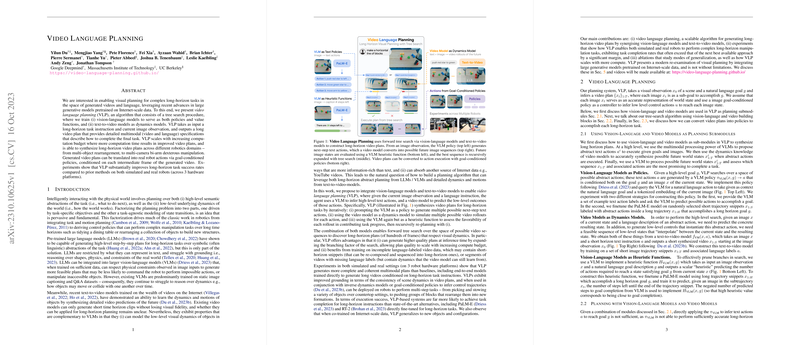Insightful Overview of "Video Language Planning"
The paper "Video Language Planning" presents an integrated approach for visual planning in robotics, capitalizing on recent advancements in LLMs and text-to-video generative models. The authors propose an innovative algorithm named Video Language Planning (VLP), which orchestrates visual and linguistic planning to handle complex long-horizon tasks through multimodal outputs. This approach is particularly noteworthy as it amalgamates the ability of vision-LLMs (VLMs) to generate high-level plans with the capability of text-to-video models to forecast detailed lower-level dynamics.
Methodological Contributions
The VLP framework constitutes a tree-search procedure that integrates VLMs and text-to-video dynamics. The core components include:
- Vision-LLMs as Policies and Value Functions: These models predict subsequent actions and estimate how conducive these actions are in advancing towards a given task.
- Text-to-Video Models as Dynamics Models: These models simulate potential sequences of "video frames" or state transitions given a proposed textual command and a snapshot of the current scenario.
- Planning Mechanics: The VLP uses a branching-forward tree search algorithm to expand possible action-video sequences. It incrementally builds a coherent and feasible video plan by selecting video rollouts that exhibit the highest heuristic value, leveraging the VLM-assisted evaluation.
Experimental Validation
Empirical evaluations elucidate the effectiveness of VLP across several robotic domains, including object rearrangement and bi-arm dexterous manipulation tasks. The experiments conducted across simulated and real environments (on three different robotic platforms) demonstrate a substantial enhancement in task success rates over the state-of-the-art. Notably, VLP outperformed alternatives such as PaLM-E and RT-2, particularly in tasks requiring intricate manipulation sequences, signifying its superior planning and execution prowess.
Strong Numerical Results and Computational Scalability
The paper underscores that VLP's planning quality scales positively with increased computational resources. For instance, experiments in complex environments like multi-object and multi-camera setups revealed that enlarging the branching factor in planning substantively elevates task success rates. For "Move to Area" tasks, VLP achieved a dramatic improvement in success rates, highlighting its capability to manage intricate task dynamics.
Theoretical and Practical Implications
Theoretically, VLP re-evaluates traditional visual planning paradigms by integrating pre-trained models on vast datasets, thereby raising crucial questions about the boundaries of high-dimensional state representations (e.g., image frames). Practically, VLP shows potential for diverse applications, not limited to robotics but extending to any domain that benefits from predictive visual planning, such as autonomous navigation and advanced media generation.
Future Speculations in AI
The future trajectory of VLP may evolve through enhancements in model training routines and increased model scales. This evolution could result in more robust systems capable of executing tasks with heightened complexity or under substantial environmental uncertainties. Furthermore, leveraging advancements in reinforcement learning could refine dynamics modeling, fostering more accurate representations and simulations of real-world physics.
Concluding Remarks
In conclusion, VLP is a noteworthy step toward unified multimodal planning frameworks, offering new insights into crafting intelligent systems capable of synthesizing extended video plans for practical action realization. However, the paper also acknowledges existing limitations like the reliance on 2D state representations and occasional inaccuracies in video dynamics, which could be fertile grounds for future research. Such explorations will be imperative in further integrating large-scale generative models into effective and scalable AI planning solutions.
